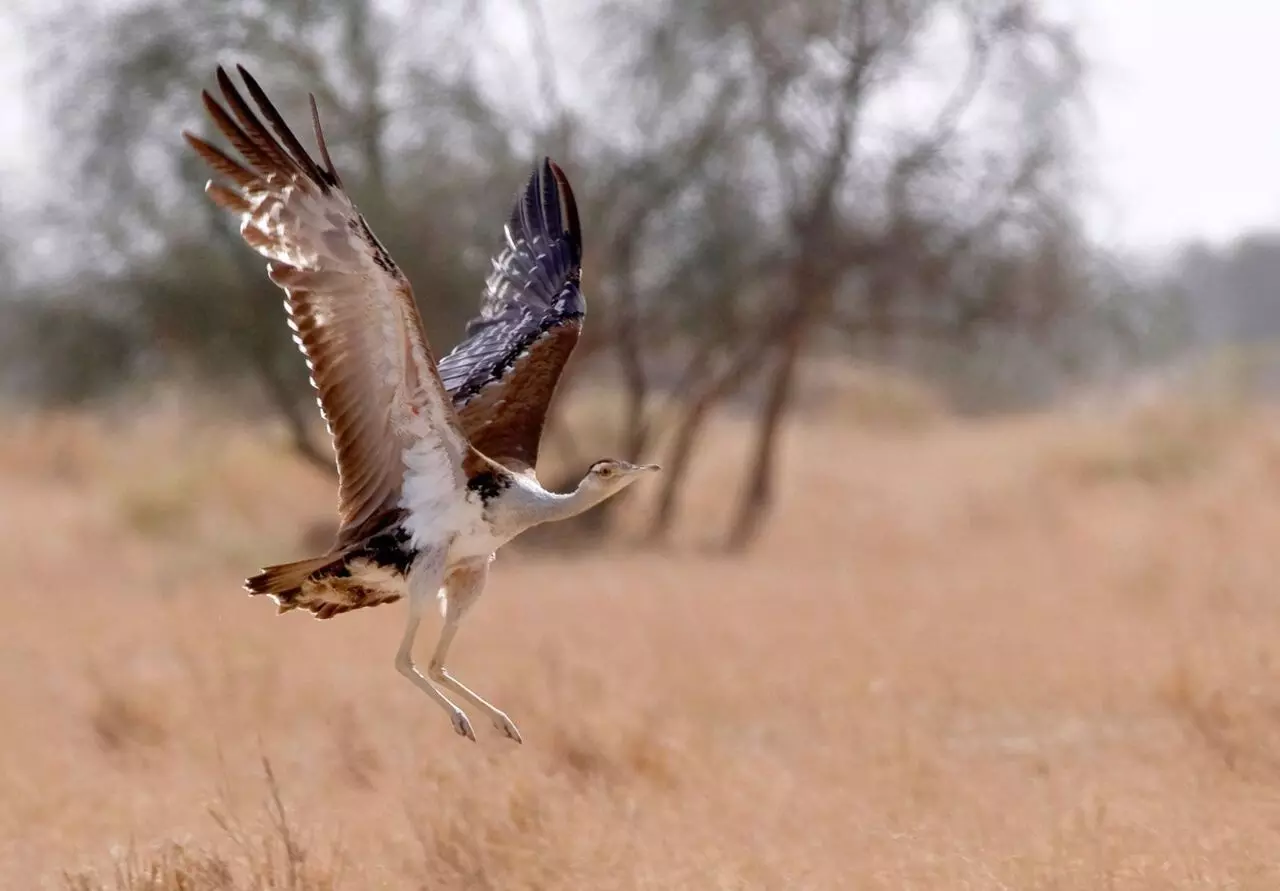Great Indian Bustard on verge of extinction; 2 captive breeding centers opened in Rajasthan
From 1,000 in 1980 to less than 150 now, the numbers have come down shrinking its habitat. Its population of about 150 in Rajasthan accounts for 95% of its total world population.
By Sri Lakshmi Muttevi
Ahmedabad: Do you know that the heaviest flying bird--Great Indian Bustard-- which was once found in 12 states, has lost 90% of its habitat and is confined to three small pockets.
Waking up to the disaster, two captive breeding centers are being set up in Rajasthan to raise its population.
Once in race of National Bird
Great Indian Bustard or GIB, the state bird of Rajasthan was once in the race to be India's national bird.
GIBs are large birds with horizontal bodies and long bare legs, have an ostrich-like appearance - and are one of the heaviest flying birds. In India, most of these birds are situated in Rajasthan, where it is locally known as 'godawan'.
In India, the bird was historically found in Punjab, Haryana, Uttar Pradesh, Madhya Pradesh, Chhattisgarh, Odisha, Andhra Pradesh, Rajasthan, Gujarat, Maharashtra, Karnataka and Tamil Nadu. According to wildlife experts, GIBs are now found in Rajasthan, Gujarat, Madhya Pradesh, and Andhra Pradesh.
Their numbers have declined to just four to five in other states, except Rajasthan. As few as 150 individuals were estimated to survive in 2018 (reduced from an estimated 250 individuals in 2011).
In Rajasthan, their numbers have come down to 50 or 60 from 250 in the past 20 years in the absence of concerted efforts to preserve the endangered species. Of the total population of around 140 now, only four female Great Indian Bustards remain in Gujarat. Only two GIBs are left in the state at the Great Indian Bustard Sanctuary in Nannaj, Solapur.
Why is the population dwindling?
GIB has been categorized as critically endangered by the International Union for Conservation of Nature (IUCN).
The population of GIBs dwindled mainly due to poaching, and because of the particular diet these birds need. Hunting had wiped out most of its population till 1972 when hunting was banned. From 1,000 in 1980 to less than 150 now, the numbers have come down shrinking its habitat. Its population of about 150 in Rajasthan accounts for 95% of its total world population. The bird is facing a threat to their survival because of intensive agricultural practices, the laying of power lines, and industrialization.
The biggest threat to these birds is the overhead high-tension wires.
In the past, they were heavily hunted for their meat and sport, and, today, poaching of the species may continue. In some places, such as Rajasthan, increased irrigation by the Indira Gandhi Canal has led to increased agriculture and the altered habitat has led to the disappearance of the species from these regions.
Project for conservation
Recently, Union Minister for Environment, Forest & climate change Bhupender Yadav said that conservation efforts are being made and the two breeding centers in Rajasthan are doing a good job.
"I am assured about the ongoing conservation program for GIBs. For conservation, we must introduce them to the wildlife after taking them out of the incubator. We are taking care of all of it. I am reiterating that development and environment can go hand-in-hand," Yadav said.
The Ministry of Environment, Forest & climate change has undertaken the project for the conservation of 13 main rivers in the country, by increasing tree plantation along the river beds, setting up sewage treatment plants wherever human settlements are close to the rivers, and protecting and preservation of the original sites of rivers.
India is committed to removing the degradation of land, for which a 26 million hectare target has been set. The government is also encouraging a sustainable and climate-resilient blue economy and is committed to promoting a circular economy.
To a question about overhead cables being one of the causes of the drop in GIB population, the Union Minister said they had contributed to only four deaths. "I believe that through the breeding program launched by us, we will certainly increase its numbers...I can say with confidence that we are committed to its conservation and preservation," the minister said.
In 2020, nine chicks were incubated successfully creating a world record.
Slow-life history
GIBs make local movements but these are not well understood although it is known that populations disperse after the monsoons.
It is a large bird and is considered 'extinction-prone' due to its slow life-history traits and struggle for survival in human-dominated landscapes. It usually lays one egg, and the male does not take responsibility for parental care. Only the females are involved in the incubation and care of the young. The eggs are at risk of destruction by other animals, particularly ungulates and crows, so the females may use a distraction display that involves flying zigzag with dangling legs
The chick remains with the mother for at least a year to learn survival skills.
Mostly found in semi-arid grasslands
It is most often found in arid and semi-arid grasslands, open country with thorn scrub, and tall grass interspersed with cultivation. It avoids irrigated areas. The major areas where they are known to breed are in central and western India and eastern Pakistan. The dry semi-desert regions where it was found in parts of Rajasthan have been altered by irrigation canals that have transformed the region into an intensively farmed area.
Maha govt in plans for conservation
The Maharashtra government is in talks with the state governments of Rajasthan, Haryana, and the Bombay Natural History Society (BNHS) to establish in and ex-situ conservation programs for GIBs. Grasslands in Solapur and Ahmednagar are the only suitable habitats left for the bird in Maharashtra.
Officials have identified a place for captive breeding near Nannaj. Once the state gets permission from the Centre, the works are to begin.
Inputs from PTI